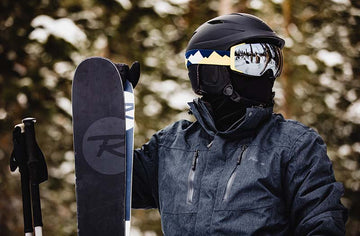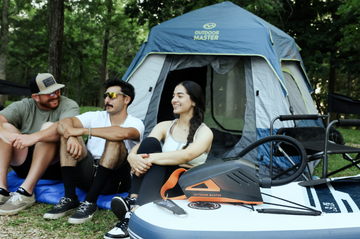
スキーは難しいスポーツのように思えるかもしれません。オリンピックのスキーヤーが急斜面を滑降する様子や、 巨大なジャンプから飛び出します。
スキーを始めるのは、難しくて怖いプロセスである必要はありません。年齢に関係なく、ほとんど誰でもスキーができます。 または身体能力。
時間と労力を惜しまない人にとって、スキーは信じられないほど楽しく、やりがいのある体験になり得ます。 まだ始めたばかりなら、良いスタートを切るために役立つ 10 のヒントをご紹介します。
スキー初心者のための10のヒント
目次
1. レッスンを受ける2. 評判の良いスキースクールを探す3. レンタルを利用する まずは装備。4 . ヘルメットを着用。5 . 成功のための服装! 6. 衣服に加えて、他に必要なものがいくつかあります。7 . 転倒が怖い。8 . スキーを習得するのにかかる時間は、さまざまな要因によって異なります。 要因。9 . シーズンパスを購入する。10 . 定期的に練習する。よくある質問1. 初心者スキーヤーにとって最も重要なこと レッスンを受けることです。

スキーのレッスンを受けることで、スキーの成功率は飛躍的に高まります。スキー場に行って、初心者のスキーヤーを連れて行きましょう。 PSIA認定者からのレッスン インストラクター。ほとんどの丘では、レッスン、レンタル、リフトを含む初心者向けパッケージを提供しています。 チケット。とてもお得なので、初めてスキーに行く方はぜひ購入してください。
友人、配偶者、友人の友人にスキーを教えてもらえますか?可能ですが、 専門家の助けを借りました。妻にスキーを教えましたが、大変な労力とストレスがかかり、私は 他の人にもそうするように勧めます。
最初のスキーレッスンでは、簡単な斜面を安全に滑れる程度に覚えれば十分です。 初めてのスキーレッスンでは次の点に注意してください。
-
スキーブーツの履き方
-
スキーブーツを履いたままスキービンディングの出し入れをする方法
-
スキーを履いて雪の上を歩く方法
-
転んだときに起き上がる方法
-
ウェッジ/ピザ/スノープラウテクニックを使ってスキー板で緩斜面で止まる方法
-
ウェッジ/ピザ/スノープラウテクニックを使って、簡単な坂道で左折と右折をする方法
-
スキーリフトの乗り方(乗り方、降り方、安全バーの使い方など)
-
スキーの基本的なエチケット、例えば斜面の真ん中ではなく端で止まる
2. スキーレッスンに関しては、 評判の良いスキースクールを見つけることが重要です。
良いレビューがあり、初心者向けのレッスンを提供している場所を探すために、少し調べてみましょう。 スキーは一貫性が大切です。スキースクールはそれぞれ決まったやり方で物事を進めています。
ある山のインストラクターから別の山のインストラクターに変わると、 学習の繰り返しです。可能であれば、最初の数回のレッスンは同じ場所で受けるのが最適です。 どこかに1週間のスキー旅行に出かけ、毎日レッスンを受けることは、良いスタートを切るための素晴らしい方法です。 進行。
3.まずはレンタル機器をご利用ください。
初めてスキーをする場合は、用具をレンタルすることを検討してみてはいかがでしょうか。そうすれば、スキーが自分に合うかどうか確かめることができます。 自分の道具に投資する前に、スキー用具は高価です。初心者用具は初心者レベルです。 上達するには、より高度な機器が必要になります。最初の数回はレンタルして、本当に気に入るかどうか確かめてみましょう。 その後は、機器の購入を検討する時期かもしれません。
ギアを購入する場合は、信頼できるスキーショップに行って、適切なものを選ぶのを手伝ってもらうのがベストです。 スキーブーツとスキー板は、あなたの能力に合ったものを選ぶ必要があります。スキーブーツのフィット感は非常に重要ですが、多くのスキーショップはスキーブーツのフィット感を知りません。 ブーツ。スキーインストラクターや上級スキー仲間に、スキーブーツを買うのにおすすめのお店を聞いてみましょう。
-
初心者用スキーは、隣に立ったときに顎まで届く長さが理想的です。スキーが長いほど、ターンや 強く止めれば、あなたはそれを望まなくなります。
-
ヘルメットは忘れずに。場所によってはヘルメットのレンタルに追加料金がかかるところもあります。ここでケチってはいけません。
-
最初のレッスンにポールは必要ありません。多くの人にとって、ポールは邪魔になるだけです。 これらは、平行回転を習得するまで必要のない、より上級者向けのアイテムです。
-
スキーブーツのフィット感はスキー用品において最も重要な要素です。緩すぎると、良いフィット感が得られません。 コントロールが効かないと、すねやつま先がブーツの中でぶつかってしまいます。また、きつすぎると、 快適
4. ヘルメットを着用してください。
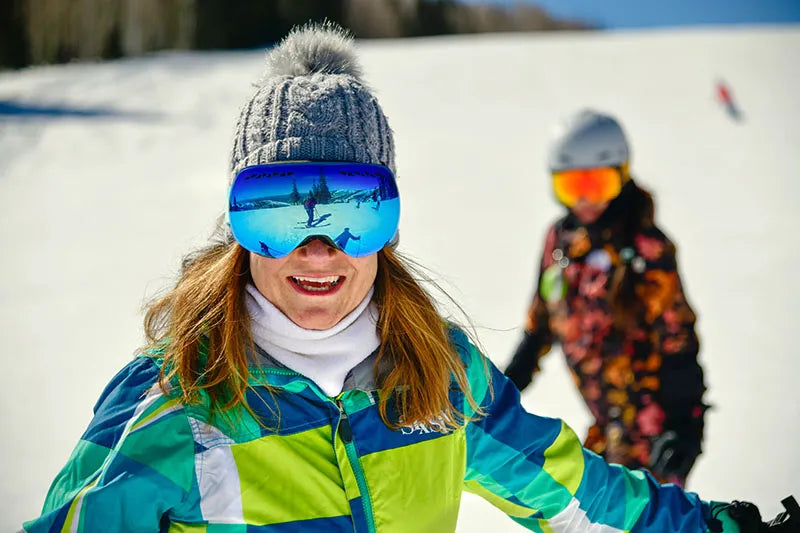
スキーヘルメットは快適で、頭を暖かく安全に保ちます。頭を守るためだけではありません。 転倒の危険からあなたを守ります。また、他のスキーヤーや危険物からあなたを守ります。
私の友人は、制御不能なスキーヤーがリフトの横に立っていたときに脳震盪を起こしました。 彼を轢いた。
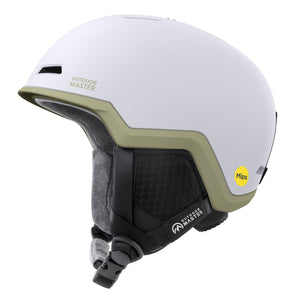
ダイヤモンドミップススキーヘルメット
今すぐ購入コードを使用する: OMBLOG20で10%オフ
5. 成功のために服装を整えましょう!

最初は重ね着をして暖かく快適に過ごせるようにすることが重要です。 斜面では滑りやすいので、転倒の恐れがあるので防水性のある服を着ることをお勧めします。
ジーンズを着て外出するのはやめましょう。ジーンズは濡れると、最も悲惨で不快な衣服になります。 水が凍ります。最低でもスノーパンツと冬用のコートを用意してください。下に長ズボンや下着を着用してください。 暖かいウールのスキーソックスやその他の冬用ソックスを用意しましょう。こちらのガイドをご覧ください。 スキーをするときに何を着るべきか、さらに役立つヒントをご覧ください。
一部のスキー場では、スキー板とブーツだけでなく、ウェアもレンタルしています。大規模なスキー場以外では、それほど一般的ではありません。 リゾート。計画を立てる前に、スキーリゾートでウェアのレンタルがあるかどうかを確認してください。
現在、スキーウェアをオンラインでレンタルできるサイトがいくつかあります。Kitlender.comがその一つです。 より人気のあるもの。
6. 衣服以外にも、 他に必要なもの。
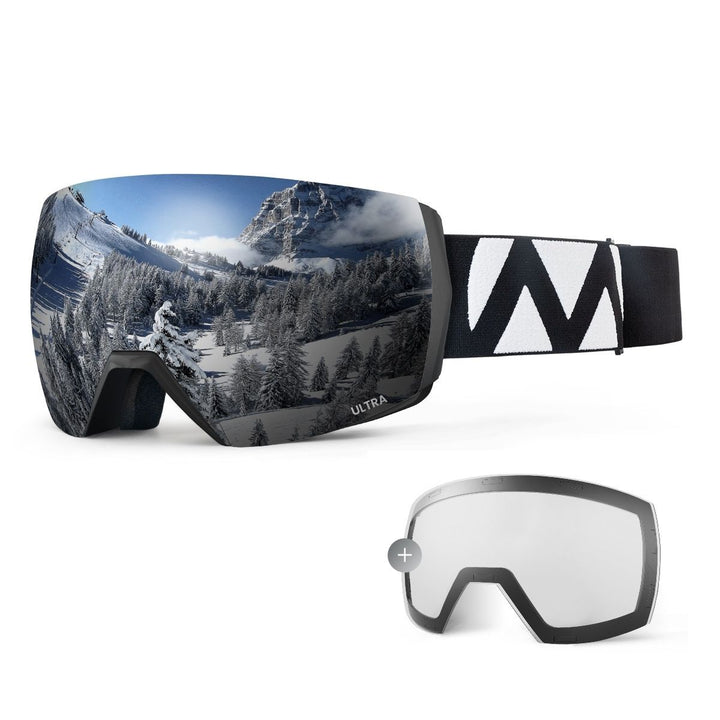
ULTRA スノーゴーグル + レンズバンドル
カラー最適化、スーパーHD、3倍の曇り止め コーティング
今すぐ購入コードを使用する: OMBLOG20で10%オフ

VISION トーリックゴーグル + ボーナスレンズ
トーリックレンズ、曇り止めコーティング、強化偏光 レンズ
今すぐ購入コードを使用する: OMBLOG20で10%オフ
スキーをするために必要なその他のものには、手袋、ゴーグル、日焼け止めなどがあります。
防水手袋は本当に重要です。転んだり、雪の中に手を入れたりすることも多々あります。 起き上がる。
スキーゴーグルは、日差しや風から顔を守り、スキーをより快適にします。 最初の数回の旅行には50ドル以下の安価なゴーグルセットがおすすめです。200ドルのスノーゴーグルは必要ありません。 まだ学習中です。
冬に日焼け止めは本当に必要ですか?はい、山の上では太陽が明るく、反射も強いので 雪が顔に降りかかることがあります。日焼け止めとSPF入りのリップクリームを塗れば、ゲレンデで日焼けするのを防ぐことができます。
スキーをする友達の中には、余分のゴーグル、手袋、スキーロック、その他のアクセサリーを持っている人もいるかもしれませんので、頼めば借りることができます。
7. 転ぶことを恐れないでください。
そんなに痛くないよ。学ぶ時は誰でも転ぶものだ。遅かれ早かれ、ピザはフライドポテトに変わる。 スキーの先端が交差し、転倒してしまいます。
幸いなことに、ほとんどのスキーでの転倒はそれほど痛くありません。横に倒れるだけです。雪は 転倒する可能性のあるほとんどの表面。転倒は起こるものであり、また起こるものなので、あまり心配する必要はありません。 わかった。
8. スキーを習得するのにどれくらいの時間がかかるか さまざまな要因によって異なります。
ほとんどの人は初日に初心者コースを安全に滑る方法を学ぶことができます。最初のレッスンの後は ウェッジターンして停止できるはずです。
パラレルターンで滑降するなんて無理です。滑降の仕方を習得するには10日から20日かかります。 急斜面でのパラレルターンを上手にこなす。運動能力に恵まれていない妻でも、スキーをすることができた。 20 日目までにバーモント州と西部の整備されたブラック ダイヤモンド スキー場を制覇。結果は人によって異なる場合があります。
下のビデオは、私の妻のスキーの1日目から18日目までの進捗状況を示しており、 スキーの習い事はこんな感じです。
9. シーズンパスを入手します。
リフト券の料金はすぐにかさみます。スキーを真剣に習いたいなら、 できるだけ頻繁に滑るようにしましょう。リフト券の料金を毎回確認すれば、シーズンパスの購入はすぐに納得できるでしょう。
同じ丘に4~5回以上行く場合は、シーズンパスの方が安くなるのが一般的です。 パスを購入したら、すでに料金を支払っているので、スキーに行かないという言い訳はできません。
Epic Pass 、 Ikon Pass 、 Indy Passなどのシーズンパスがあり、 アメリカやカナダ(ヨーロッパ、南米、アジアも)の様々な山々に適しているので、 たった一つの山でスキーをするしかなかった。
10. 基本を学んだら スキーでは、スキルを向上させたいなら定期的に練習することが重要です。

スキーで垂直落下を経験することに代わるものはありません。スキーをすればするほど、ターン能力が向上します。 バランススキルも向上します。誰もが中級、上級レベルに到達し、空を舞いながら 山の平行旋回。
最初のシーズンでそこに到達する唯一の方法は、たくさんスキーに行くことです。妻がスキーを習っていた頃、私たちは 冬の間、少なくとも隔週で行くつもりでした。
最後に、楽しむことを忘れないでください!スキーはとても難しいスポーツですが、楽しむことも大切です。だから 恐れずに実験し、自分に最適なものを見つけてください。
スキーの始め方に関するよくある質問
Q: スキーを独学で習得できますか?
A: はい、可能です。ただし、認定スキーインストラクターのレッスンを受けることをお勧めします。インストラクターは適切なテクニックを学ぶお手伝いをします。 スキーが難しくなったり、楽しくなくなったりする可能性のある悪い習慣を避けましょう。
最も最悪なことの一つは、山へ行き、チケットを買って、何もせずに山頂まで直行することです。 レッスンを受けてください。落ちずに降りることはできません。すぐにコントロールを失う可能性が高いです。あなたはとても 自分自身だけでなく、他の人も傷つける可能性があります。そんな人にならないでください。レッスンを受けましょう。
Q: 友達が私にスキーのやり方を教えてくれますでしょうか?
A: 友人は素晴らしいスキーヤーかもしれませんが、あなたにスキーを教えるのに最適な人ではないかもしれません。認定スキーヤー インストラクターは、学習に役立つ適切な指導とフィードバックを提供することができます。
Q: スキーを習うのは簡単ですか?
A: スキーの基本を学ぶのは比較的簡単で、ほとんどの人はスキーを一度習得すれば初心者用の斜面を滑ることができます。 最初のレッスン。しかし、熟練したスキーヤーになるには、時間と練習、そして忍耐が必要です。
Q: 1日でスキーを習得できますか?
A: ほとんどの初心者向けスキーレッスンは、リフトに乗って滑降できるようになることを目指しています。 初日の終わりに安全に山を登れるように。基本的なウェッジターンとストップ、そして リフトに安全に乗れるように。1日目の終わりにブラックダイヤモンドを滑ることはできません。 バニースロープ。人によってはもっと長い距離が必要なので、1日目を終えても滑りにくさを感じても心配しないでください。 丘はまだです。
Q: スキーが上手くなるにはどれくらい時間がかかりますか?
A: 「良い」というのは、パラレルターンやホッケーストップができ、 ブルーとブラックダイヤモンドのコースを滑る。ほとんどの人は、このレベルに達するまでに10日から20日間のスキー日数がかかる。 良い指導とたくさんの練習。
Q: 40 歳を超えていますが、まだスキーを習うことはできますか?
A: はい!年齢はスキーを始める上で障壁にはなりません。100歳を超えてもスキーを楽しんでいる人もいます。 冬の間ずっと毎日。妻は30代後半でスキーを習い始めました。私は上級のスキーレッスンを受けたことがあります。 ブリティッシュコロンビア州ウィスラーでは、私たちのグループの中で最も上手なスキーヤーが 60 代や 70 代だったことが何度もありました。
Q: スキーをするには体調を整えておく必要がありますか?
A: スキーは体力的に厳しいスポーツですが、必ずしもそうである必要はありません。最高の体力である必要はありません。 整備されたクルーザーコースでスキーを習う、または滑るのに最適なコンディションです。平均的な体力で、少し体重があれば誰でもスキーを習うことができます。
Q: スキーとスノーボードではどちらが習得しやすいですか?
A: スキーの初日はスノーボードよりも簡単です。スキーの基礎を学ぶ方が、スノーボードの基礎を学ぶよりも簡単です。 スノーボード。スノーボードで止まってターンする方法を習得したら、同じテクニックをスノーボードで磨くだけです。 より急な斜面。基本的なウェッジターンとスキーでの停止を学んだ後、パラレルターンを習得する必要があります。 停止と滑走は全く異なるスキルです。スノーボードの場合は、初期の習得曲線がより急峻です。パラレル ターンスキーやカービングは、スノーボードでのカービングターンよりも習得に時間がかかり、困難です。
Q: 屋内でスキーを習うことはできますか?
A: 幸運にもニューヨークのビッグスノーのような屋内スキー場の近くに住んでいるなら、 ジャージー島はスキーを学ぶのに最適な場所です。優秀なインストラクターと非常に 均一な雪面。
まとめ
基礎を学んだら、いよいよゲレンデへ出かけましょう。スキーは難しいものです。 スポーツですが、とても楽しいです。
認定スキーインストラクターからレッスンを受けて、正しいテクニックを習得し、悪い習慣を避けましょう。 転ぶのは怖いけど、みんな怖いから。何より、楽しむことが大事!


